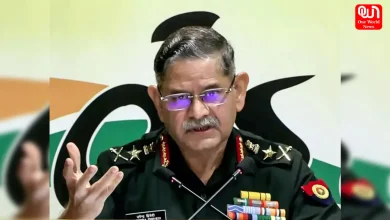Is India’s Economic Growth Losing Momentum? Examining Wages, Inflation, and Middle-Class Challenges
India's GDP growth faces hurdles as falling wages, inflation, and reduced middle-class spending challenge economic momentum and government growth goals.
Is India’s GDP Growth Slowing? The Role of Falling Wages, Inflation, and Middle-Class Challenges in Shaping Economic Prospects
India’s growth story-often touted as one of the fastest globally-is at last showing signs of strain. While a commendable 8% GDP growth during the past fiscal year is still nothing to discount, cracks are beginning to emerge in the urban middle class: the key driver of consumption and overall economic momentum. The more recent contraction in real wages, along with plummeting corporate profits, reveal even bigger challenges that might scotch the country’s ambitious growth trajectory.

Read more: ED Officers Attacked During Cyber Crime Investigation in Delhi; FIR Filed
Falling wages: A significant setback
Indian wages contracted for the first time since the pandemic. Inflation-adjusted employment cost for non-financial listed companies, which serves as a proxy for urban wage health, declined 0.5% in the July-September quarter from a year earlier, Elara Securities Inc. said. The uptick in inflation has meant that financial stress for urban households has worsened. Analysts have cited subdued hiring in technology sectors and declining profitability in manufacturing as critical factors behind flat wage growth.
Major IT companies including Tata Consultancy Services Ltd, Infosys Ltd, Wipro Ltd and HCL Technologies Ltd reported a rather bleak 3.3% hike in employee costs this quarter versus 8% a year earlier. Incomes are not keeping pace with prices, and households need either to draw down savings or build up debt to stay aloft at current expenditure, a disturbing trend for any economy that is as much based on consumer spending as is that of India.
The Urban Middle Class: A Struggling Growth Engine
The urban middle class is the consumption driver across industries, and it is feeling the pinch. Spending on essentials and discretionary items has declined, reflecting financial constraints. Major companies like Maruti Suzuki Ltd. and Hindustan Unilever Ltd. have reported weaker earnings, which they attribute to subdued consumer demand. Almost half the companies in the NSE Nifty 50 Index also missed their earnings projections in the second quarter, pointing to a broader economic malaise.
A 60% contribution to GDP of India, consumer spending continues on a sharp deceleration phase. Analysts from Motilal Oswal Financial Services Ltd feel that weak consumer finances on the back of anaemic growth of income are major factors why economy is under pressure.
Economic Challenges in Driving Growth
For Prime Minister Narendra Modi’s administration, the slowdown presents a serious obstacle to achieving long-term economic objectives, including job creation. Calls for interest rate cuts to stimulate growth have emerged from finance and trade ministers. However, the Reserve Bank of India (RBI) has maintained its focus on controlling inflation, with Governor Shaktikanta Das warning against premature rate easing due to persistent inflation risks.
The government’s capital spending is also lackluster. In the first half of the fiscal year, only 37% of the budgeted public spending target of ₹11.1 trillion was spent, compared with 49% in the same period last year. Though officials expect a pick-up in spending in the second half, slow state-level disbursements may temper the overall impact.
Revised Growth Projections
Economists have started trimming growth forecasts for the current fiscal year. Elara Securities trimmed it to 6.8% from the earlier 7.1%, and Goldman Sachs sees 6.4%. The RBI continues to be more sanguine, with its forecast remaining at 7.2%. The gap betrays conflicting perceptions of when the economy can recover from its present woes.
Resilience in Rural Areas: A Silver Lining
In the midst of urban struggles, rural spending may be a potential bright spot. A strong agricultural harvest and improving rural incomes will likely boost this trend. As Bloomberg Economics puts it, delayed government spending due to the April-May elections is now catching up, which should help rural consumption even more.
But this early revival will not be sufficient to alleviate short-term urban blues. Growth in rural consumption needs to be maintained over time for any meaningful impact on the economy as a whole.
The Road Ahead: Stepping into Uncertainty
During these economic headwinds, India’s trajectory will depend on several factors.
Consumer Confidence and Spending: Rebuilding consumer confidence is important. Unless spending is augmented, corporate earnings and investment will remain weak, continuing to weigh on economic growth.
Government intervention: An increase in public expenditure, mainly on infrastructure and social welfare, would boost demand and generate employment. Increasing the pace of state-level expenditure is also important.
Monetary policy adjustments: The RBI has opposed the demand for a cut in rates. Softening monetary policy could still bring much-needed relief to the business and household sector and trigger a consumption turnaround.
Taming inflation: Curbing inflation will be key to preventing further erosion of real wages and purchasing power.
Strengthen Rural Contributions: Harnessing rural consumption growth can offset the drop in urban demand, but this would need strategic investment in agriculture and rural infrastructure.
Read more: Horrific Accident on Lucknow-Agra Expressway Claims Lives of Four Doctors and a Lab Technician
Conclusion: An Opportunity Amid Challenges
India’s current slowdown is not without precedent; many fast-growing economies go through periodic corrections. Even as falling wages and constrained middle-class spending are immediate causes for concern, the deeper fundamentals of the Indian economy—its large and young workforce, burgeoning entrepreneurial ecosystem, and strong global positioning—are still sound.
Now, strategic interventions like increased fiscal spending and a balanced monetary policy can steer the economy back on track. Till now, policymakers, businesses, and consumers have to go through such challenging times with resilience and focusing on long-term growth.
We’re now on WhatsApp. Click to join.
Like this post?
Register at One World News to never miss out on videos, celeb interviews, and best reads.








